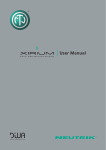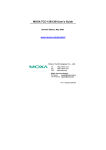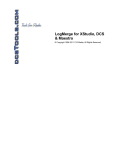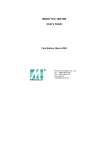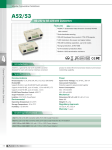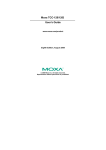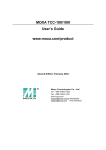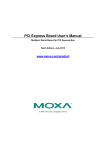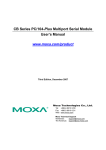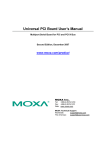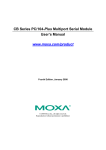Download MOXA TCC-120/120I User`s Guide
Transcript
MOXA TCC-120/120I User’s Guide www.moxa.com/product Fourth Edition, March 2004 MOXA TCC-120/120I User’s Guide The software described in this manual is furnished under a license agreement and may be used only in accordance with the terms of that agreement. Copyright Notice Copyright 2004 Moxa Technologies Co., Ltd. All rights reserved. Reproduction without permission is prohibited. Trademarks MOXA is a registered trademark of Moxa Technologies Co., Ltd. All other trademarks or registered marks in this manual belong to their respective manufacturers. Disclaimer Information in this document is subject to change without notice and does not represent a commitment on the part of Moxa. Moxa provides this document “as is,” without warranty of any kind, either expressed or implied, including, but not limited to, its particular purpose. Moxa reserves the right to make improvements and/or changes to this manual, or to the products and/or the programs described in this manual, at any time. Information provided in this manual is intended to be accurate and reliable. However, Moxa Technologies assumes no responsibility for its use, or for any infringements on the rights of third parties that may result from its use. This product might include unintentional technical or typographical errors. Changes are periodically made to the information herein to correct such errors, and these changes are incorporated into new editions of the publication. Table of Contents Chapter 1 Introduction ......................................................................................1-1 Chapter 2 Installation ........................................................................................2-1 Appendix A Service Information ........................................................................ A-1 Overview ................................................................................................ 1-2 Product Features.................................................................................... 1-3 Package Checklist.................................................................................. 1-3 Product Specifications............................................................................ 1-4 Product Views ........................................................................................ 1-5 LED Indicators........................................................................................ 1-5 Hardware Installation ............................................................................. 2-2 MOXA Internet Services.........................................................................A-2 Problem Report Form.............................................................................A-3 Product Return Procedure .....................................................................A-4 Revision History .....................................................................................A-5 1 Chapter 1 Introduction TCC-120/120I is a RS-422/485 isolated repeater. TCC-120I has 2 KV isolation protection. The following topics are covered in this chapter: Overview Product Features Package Checklist Product Specifications Prodcut Views LED Indicators Overview Introduction Many important devices used in today’s industrial environment use the RS-422 or RS-485 interface for data transmission. In some cases however, it is necessary to extend the transmission distance between RS-422/485 devices. This is where TCC-120/120I RS-422/485 Repeater comes in. Simply wire the power block, wire the two signal blocks, set the DIP switches, and you’re ready to go. The RS-422/485 standards use a differential signal for transmitting data signals. In addition to distance and multi-drop issues for industrial applications, housing, wiring, power supply, and over-surge protection are also serious concerns. TCC-120I also provides isolation protection for users who need an industrial grade repeater to extend RS-422/485 transmission distance and increase networking capability. The superior industrial application design of this product, which includes DIN-Rail mounting, terminal block wiring, external terminal block power, and optical isolation for system protection, makes TCC-120/120I suitable for use in critical industrial environments. Built-in RS-485 ADDC™ Intelligence ADDC™ (Automatic Data Direction Control), a MOXA leading technology, uses a clever hardware solution to take care of RS-485’s data flow control problem. ADDC™ is a hardware data flow solution that automatically senses and controls data direction, making the handshaking signal method obsolete. Isolation MOXA’s electrical isolation technology uses two photo couplers to create a gap in each electrical signal. One photo coupler transforms the electrical signal into a light signal, which is transmitted across a small gap, and then the other photo coupler transforms the light back into an electrical signal. In this way, the two electrical circuits are completely isolated from each other, limiting the damage that could otherwise be caused by power surges in the electrical signal. Reverse Power Protection The Reverse Power Protection feature provides extra protection against accidentally connecting the power cables to the wrong terminal. The converter is designed to automatically detect which power wire is positive and which is negative, and then adjust the power supply accordingly. DIP Switch Selectable Terminator For many products of this type, the termination resistor is set by a jumper located inside the product’s casing, so that the user must open the casing to disable or change the resistor’s strength. MOXA offers a better solution. TCC-120/120I’s terminator is set with a DIP Switch located on the outside of the converter’s casing. Auto Baud Rate Detection TCC-120/120I incorporates a method for automatically detecting the serial signal’s baud rate by hardware. This is an extremely convenient feature for the user. Even if a device’s baud rate changes, the signal will still be transmitted through the RS-422/485 repeater without any problem. 1-2 TCC-120/120I User’s Manual Introduction Product Features • • • • • • • • • Boost serial signal for extending transmission distance up to an additional 1.2 km Wall or DIN-Rail mountable Terminal block for easy wiring Power input from terminal block DIP Switch enabled built-in terminator (120 ohms) PWR, Tx, Rx LEDs Embedded Surge Protection (16 KV ESD) Operating temperature from -20°C to 60°C 2 KV Isolation (for TCC-120I) Package Checklist Before installing MOXA TCC-120/120I, verify that the package contains the following items: Standard Accessories: • TCC-120 or TCC-120I • User’s Manual (this document) • Warranty Booklet • 5-contact terminal block connectors x 2 • 3-contact terminal block connector x 1 Optional Accessory • 2 DIN-Rail mounting brackets w/ 4 screws Please notify your sales representative if any of the above items is missing or damaged. TCC-120/120I User’s Manual 1-3 Product Specifications Model Names TCC-120, TCC-120I Communication Signals for 2-wire (RS-485 2-wire) Signals for 4-wire (RS-422 or 4-wire RS-485) Data+, Data-, SGND Tx+, Tx-, Rx+, Rx-, SGND RS-485 Data Direction Control ADDC™ Baud Rate 50 bps – 230.4 Kbps Surge Protection 16 KV ESD RMS, for all signals Isolation 2 KV for both Power and Signal (TCC-120I) Environment Operating Temperature -20°C to 60°C Storage Temperature -20°C to 85°C Humidity 5 to 95 %RH Power Input Power Voltage External Power 12-48 VDC, Terminal Block Reverse Power Protection Protects against V+/V- reversal Over Current Protection Protects against 2 signals shorted together Power Consumption TCC-120: 3.4 W = 12V 286 mA = 24V 143 mA = 30V 113 mA TCC-120I: 4.68 W = 12V 390 mA = 24V 195 mA = 30V 156 mA Mechanical Dimensions (W × D × H) 67 × 100 × 22 mm (casing only) 90 × 100 × 22 mm (including ears) Casing material Aluminum Plug-In Screw Terminal Block #22 – #16 AWG Color Black Weight 148±5 g Regulatory Approvals CE, FCC (Class B) 1-4 TCC-120/120I User’s Manual Introduction Product Views LED Indicators TCC-120/120I’s top panel contains three LED indicators, as described in the following table: LED Name LED Function PWR Red indicates the power is on. Data is entering through the top-end port and exiting Yellow through the bottom-end port. Data is entering through the bottom-end port and exiting Green through the top-end port. TCC-120/120I User’s Manual 1-5 1-6 TCC-120/120I User’s Manual 2 Chapter 2 Installation This chapter includes information about how to install TCC-120/120I. The following topics are covered in this chapter: Hardware Installation Hardware Installation Installing TCC-120/120I involves four straightforward steps: • • • • STEP 1: Set the terminator DIP Switches STEP 2: Attach the Power Supply STEP 3: Wire the RS-422/485 Terminal Blocks STEP 4: Test the Connection The details of each of these four steps are described next. STEP 1: Set the DIP Switches The DIP Switches on TCC-120/120I are used to set the signal transmission mode and to enable or disable the termination resistor. You can configure for either 2-wire (RS-485) or 4-wire (RS-422/485) transmission mode. Also note that your program and serial port should be set to match the repeater’s settings. NOTE TCC-120/120I has two sets of DIP Switches—one set on the top-end and the other set on the bottom-end. To ensure proper data transmission, make sure that the two sets of DIP switches are configured the same. SW1— Switch 1 selects 4-wire or 2-wire mode. Set Switch 1 to the ON position for 4-wire, and to the OFF position for 2-wire. SW2— Switch 2 enables or disables termination. Set Switch 2 to the ON position to enable termination, and to the OFF position to disable termination. For easy reference, the following figures depict the four possible settings. Dip Switch Settings RS-422/4-wire RS-485 with Terminator SW1 SW2 ON ON SW1 SW2 ON OFF SW1 SW2 OFF ON SW1 SW2 OFF OFF 4-wire, termination enabled RS-422/4-wire RS-485 4-wire, termination disabled 2-wire RS-485 with Terminator 2-wire, termination enabled 2-wire RS-485 2-wire, termination disabled 2-2 TCC-120/120I User’s Manual Installation STEP 2: Attach the Power Supply TCC-120/120I is powered by an external 12-48 VDC power supply. To connect to the power supply, run two wires from the V+ and V- terminals, on TCC-120’s 3-connector terminal block, to the DC power supply, as shown in the figure to the left. Once the power supply is connected to its power source, the PWR LED located on TCC-120’s top panel should be illuminated in red. NOTE TCC-120/120I provides reverse power protection. i.e., it will automatically detect which power wire is negative, and which is positive. STEP 3: Wire the Terminal Block There are two wiring options available for connecting to TCC-120/120I’s RS-422/485 terminal block. 2-wire When using the 2-wire (for RS-485) wiring option, you will need to connect three wires from each of TCC-120/120I’s RS-422/485 terminal blocks to the opposite connections. Connect from R+/D+ to Data+, from R-/D- to Data-, and from SGND to SGND. 4-wire When using the 4-wire (for RS-422 or 4-wire RS-485) wiring option, you will need to connect five wires from each of TCC-120/120I’s RS-422/485 terminal blocks to the opposite connections. Connect from R+/D+ to Tx+, from R-/D- toTx-, from T+ to Rx+, from T- to Rx-, and from SGND to SGND. STEP 4: Test the Connection After setting the DIP Switches, connecting the power, and wiring the terminal block, we suggest using a Console Terminal program, such as HyperTerminal or Moxa Terminal Emulator, to test the connection. If you have an RS-422/485 serial board (such as MOXA Industio CP-132) installed in your PC, you can connect your PC’s COM port to one of TCC-120/120I’s RS-422/485 terminal blocks, and connect TCC-120/120I’s other RS-422/485 terminal block to one of the RS-422/485 serial board’s ports. Next, start HyperTerminal or Moxa Terminal Emulator, and then open a connection to the COM port, and to the port associated with TCC-120/120I’s RS-422/485 port. Simply type a few characters on your PC’s keyboard. The characters you type should show up in the HyperTerminal window that is currently inactive, indicating that the typed characters were transmitted between TCC-120/120I’s two RS-422/485 ports. TCC-120/120I User’s Manual 2-3 2-4 TCC-120/120I User’s Manual A Appendix A Service Information This appendix shows you how to contact Moxa for information about this and other products, and how to report problems. In this appendix, we cover the following topics. MOXA Internet Services Problem Report Form Product Return Procedure MOXA Internet Services Customer satisfaction is our number one concern, and to ensure that customers receive the full benefit of our products, Moxa Internet Services has been set up to provide technical support, driver updates, product information, and user’s manual updates. The following services are provided E-mail for technical support ............................... [email protected] World Wide Web (WWW) Site for product information: ............................ http://www.moxa.com A-2 TCC-120/120I User’s Manual Service Information Problem Report Form MOXA TCC-120/120I Customer name: Company: Tel: Fax: Email: Date: Moxa Product: TCC-120 Serial Number: _________________ TCC-120I Problem Description: Please describe the symptoms of the problem as clearly as possible, including any error messages you see. A clearly written description of the problem will allow us to reproduce the symptoms, and expedite the repair of your product. TCC-120/120I User’s Manual A-3 Product Return Procedure For product repair, exchange, or refund, the customer must: Provide evidence of original purchase. Obtain a Product Return Agreement (PRA) from the sales representative or dealer. Fill out the Problem Report Form (PRF). Include as much detail as possible for a shorter product repair time. Carefully pack the product in an anti-static package, and send it, pre-paid, to the dealer. The PRA should be visible on the outside of the package, and include a description of the problem, along with the return address and telephone number of a technical contact. A-4 TCC-120/120I User’s Manual Service Information Revision History Document Edition Revision Date 3rd February 9, 2004 Revision Details 1. Update the edition of this manual on the title page. 2. p. 2-2 Adjust the Dip Switches figures. 3. Change to Moxa’s manual standard format. 4. p. 1-5 Under LED Indicators section: Make corrections on the figure the descriptions in the table. 4th March 24, 2004 5. Change power supply specifications from “12 to 30 VDC” to “12 to 48 VDC”. 1. p. 2-3 In STEP 3: Wire the Terminal Block, under the section of 4-wire, changed the wiring descriptions. TCC-120/120I User’s Manual A-5



















